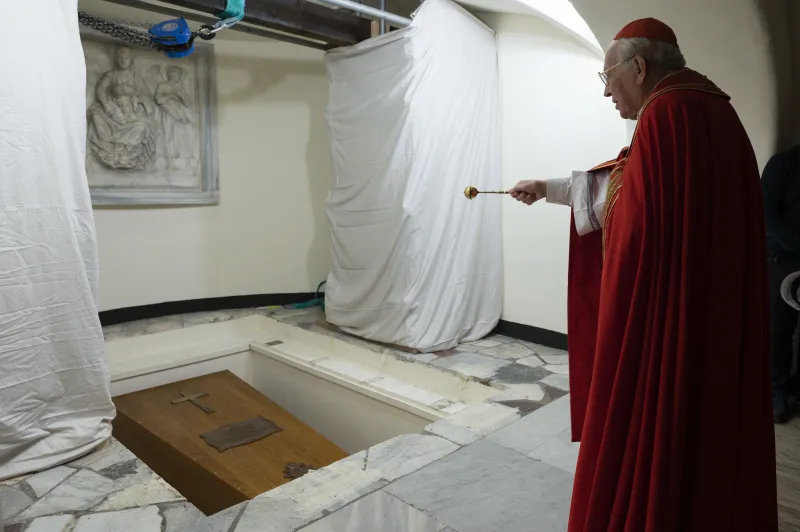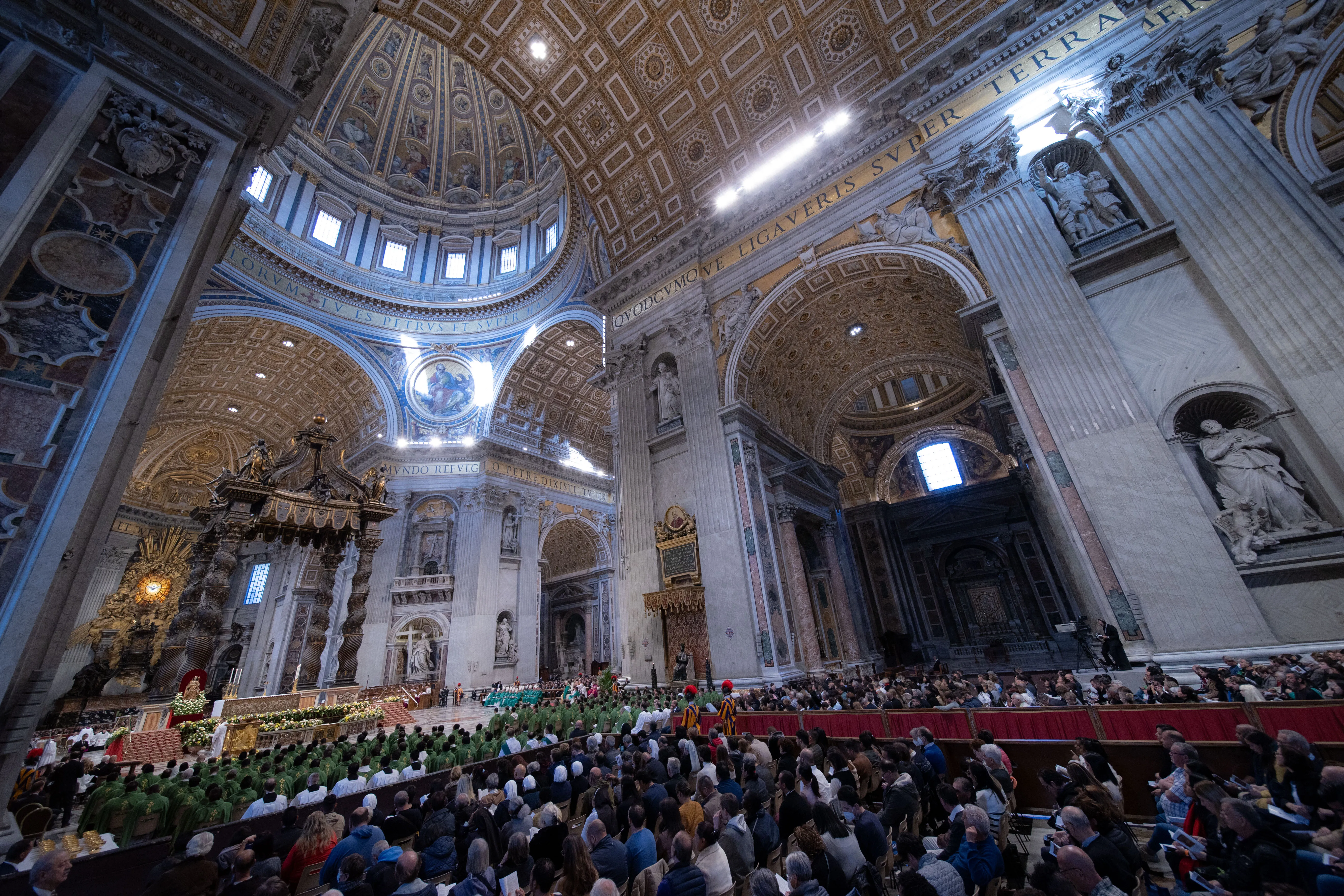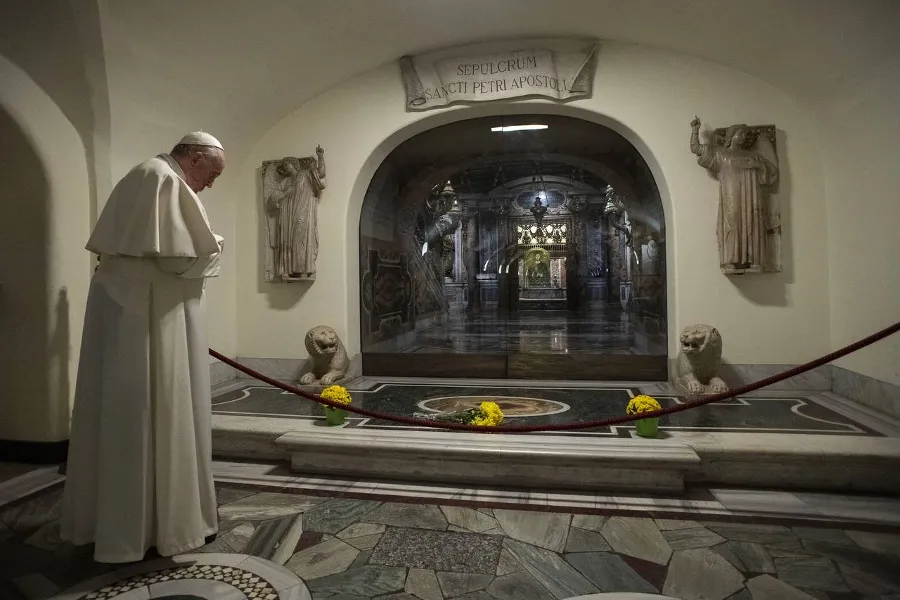
Vatican City, May 8, 2019 / 05:35 pm (CNA).- In the coming months, Pope Francis is expected to approve a final draft of a new governing constitution for the Roman Curia. Evangelium praedicate, as it is expected to be called, will mark the culmination of six years of reforming efforts led by the pope’s Council of Cardinals.
As the document gets closer to publication, some members of Roman Curia have expressed concern about the document’s current draft form, especially as it relates to the possibility of more senior roles for lay men and women.
The constitution is expected to continue the work of combining smaller “pontifical councils” with the larger, better known, “congregations” of the Vatican Curia. The stated aim of such reforms is to provide a more efficient bureaucracy, better suited to serving the pope and dioceses around the world.
Commentary has focused on a supposedly revised order of seniority among the combined curial departments, with some media outlets predicting a relegation of status for the Congregation for the Doctrine of the Faith in favor of Propaganda Fide.
The ecclesiological problems with that forecast are well known; Francis has himself insisted that “all dicasteries report directly to the pope” and that reform must proceed “on the basis of the principle that all dicasteries are juridically equal.”
And sources familiar with the draft text have noted that, while departmental seniority may be a red herring, the exercise of authority within departments is a more significant issue. Specifically, curial say, members of the C6 (formerly the C9) have been considering how lay men and women might assume senior leadership roles in the consolidated curial departments.
That possibility is already unfolding. Last year, a reconstituted Dicastery for Communications became the first curial department to have a layman as prefect. Francis has also appointed two women to serve as undersecretaries at the Dicastery for Laity, Family and Life. Laity also fill senior positions at the Secretariat for the Economy.
At this point in curial organization, according to sources familiar with the reforming efforts, some members of the C6 are pushing for the appointment of lay Catholics to positions traditionally held by cardinals.
While allowing laity to occupy more senior Vatican offices has been a much-discussed ambition in curial reform, it has generated concern among many officials.
“There is definitely a push to have a layman, preferably a woman, serve in a role traditionally and prominently held by a cardinal,” one Vatican official familiar with the drafting process told CNA.
“But there is maybe more enthusiasm than understanding in these ideas.”
Many aspects of Church life and governance require the approval of a Roman congregation acting on authority delegated by the pope, including, for example, new translations of the liturgy or the sale of Church patrimony above certain set amounts.
Some curial officials warn that reform efforts which ignore the curia’s theological link to the exercise of papal authority present a host of problems, legal and ecclesiological. Central to the issue is a theological debate about which roles in the Church’s governance require sacramental ordination, and which can be filled by lay people.
Canon law defines ordination as a necessary qualification for the exercise of the power of governance. Lay people – according to the Code of Canon Law – can “cooperate” in the exercise, but not exercise it in their own right.
“It can be good to have lay people in senior roles,” one curial archbishop who has seen a recent draft of the new constitution told CNA.
“But you cannot have laity exercising the power of governance on their own, this is clear.”
In practice, lay and clerical cooperation can be seen at the diocesan level, where, for example, lay canonists serve as judges on marriage tribunals. While lay judges may write the consensus opinions of the court, they make up a minority on judging panels, which are always chaired by a cleric.
Lay people may serve in senior diocesan roles, such as chancellor, but not in roles with a stable governing function, like vicar general. According to those working in the Roman curia, adopting a similar model in Vatican governance is not impossible.
“Certainly you could have a lay secretary of a dicastery, with acts which exercise the delegated power of governance being signed also by a prefect-cleric,” the archbishop said. “But to have a lay prefect of [for example] the CICLSAL [the department for religious orders] would mean having the pope sign everything in forma specifica for it to have authority.”
While canonists point out what they see as a potentially flawed ecclesiology in attempting to invest lay officials with the theoretical power to tell bishops or religious superiors what to do, curial officials warn that the attempt could backfire even as a gesture – noting that Rome had recently intervened to prevent similar efforts.
“They [C6] are speaking about ‘empowered’ lay leadership in the curia – I wonder how that will strike the Americans. Compared to a [lay] prefect of a governing dicastery, what they proposed [at the USCCB autumn assembly in Baltimore last year] is modest, and they were told ‘numquam,’” the Vatican official said.
Others close to the C6 have suggested that the push for lay leadership is actually less about empowering lay officials and more about draining power away from Rome altogether.
“There is a minority that sees the laity as a way to break the curia’s role,” one priest close to the C6 told CNA. “Give them the jobs they cannot do and give the power to actually do them to the episcopal conferences.”
The priest explained that since curial exercise of governance cannot be given to lay people, even if given prominent leadership positions, the exercise of that power would automatically revert back to the pope “unless it is delegated further down.”
“At least some of the [C6] cardinals see lay prefects as a way of cutting back Roman power, not just [of] the curia but [of] the pope. If you have lay prefects, you have to limit the competence [of the dicastery], and you give whatever they cannot do to the bishops’ conferences.”
“Rome gets the power of appearance of lay people in charge, lay people get the appearance of power, and the conferences get the real power,” the priest explained, “and they call it subsidiarity.”
While the coming weeks will likely see further discussion of the new Vatican constitution’s contents and release, it is clear nothing has made it past the draft stage yet.
“There is much [wider] consultation which must still happen,” the curial archbishop said. “We hope there will be more understanding after that. Too much now is the fruit of a few – what touches all must be approved by all.”
If you value the news and views Catholic World Report provides, please consider donating to support our efforts. Your contribution will help us continue to make CWR available to all readers worldwide for free, without a subscription. Thank you for your generosity!
Click here for more information on donating to CWR. Click here to sign up for our newsletter.














One priest-observer of the draft curial reform reports that by elevating the laity: “Rome gets the power of appearance of lay people in charge, lay people get the appearance of power, and the conferences get the real power, and they call it subsidiarity. Surely, this has been the endgame all along, since 2013.
Of this accurate insight, there’s more:
FIDELITY? How to evangelize both faith and morals, e.g., Veritatis Splendor, compared to a facile and dichotomous “paradigm-shift”?
RESPONSIBILITY? How to preserve the real Apostolic Church—for each bishop-member of each conference of bishops, as to what is of the collective conference (as essentially a shared administrative convenience only) and what is not? Even Church ecumenical councils–still above any national conference of bishops(?)–are something that the Church DOES, not what the Church IS.)
EVANGELIZATION? How to leaven cultures with a new accent on “fraternity” and with the irreducible difference between FAITH in the person of Christ—the singular Incarnation—and other religious “narratives”?
POLITICS? In the secular domain, how will the empowered conferences distinguish doctrine from complex national matters of prudential judgment which are the “distinctive role of the laity” (Gaudium et Spes); and of the engaged laity, in the United States especially, how will higher education ever outgrow its prolonged, adolescent exhibitionism of the 1967 Land o’ Lakes Declaration?
This is not the reform the patriarchate of Rome needs. Pray for a worthy man to become the bishop of Rome.
The counter narrative as described by Massimo Faggioli to radical ecclesial restructure continues. All of a sudden documents are flying out from Benedict’s little Vatican hermitage. “After the sensational publication of his notes’ on the scandal of sexual abuse in the Catholic Church, after the publication of his correspondence with the chief rabbi of Vienna, here comes in double time a new public statement of pope emeritus Benedict XVI, with the publication of twenty-five of his homilies, almost all of them issued for the first time. Most of them date back to the 1970’s and ’80’s, the most recent is from 2003. They are grouped by liturgical season: Advent, Christmas, Lent, Easter, and finally ordinary time” (Sandro Magister). Pastors spill out their hearts those who are abundantly loyal to Christ like pastor aeternus Benedict [as some would like to think] in their sermons. As compared to sermons emitting from Casa Santa Marta there is stark contrast. Why the sudden flow from Emeritus Benedict XVI as the super dicastery idea is coming into realization. “’Rome gets the power of appearance of lay people in charge, lay people get the appearance of power, and the conferences get the real power,’ the priest explained, ‘and they call it subsidiarity’”. Rome meaning Pope Francis is the Master pulling the strings reshaping authority likely transferred from incompetent Laity to national bishops conferences the former CDF a mute issue regarding integrity of doctrine.
There is no apostolic grace for “governance.” Governance of the Empire belongs to Caesar, not to apostles. From Templars to Westphalia to hiding pederasty to selling out Chinese Catholics in the PRC, these apostles have the courage of swamp rats. This epoch is the third time the aristocracy has divided the Body of Christ against itself in 1000 years. It will be the last.
The aristocracy has cleverly re-interpreted Neo-Platonic natural law to spiritually justify their totalistic approach to God, denying the laity the guidance to become adult children of God, over whom the aristocracy will serve as footstool.
Replace the bishops with lictors of the dioceses, elected by the faithful, appoint saintly apostles who will effectively teach us the deification of human being, and fulfillment of Jesus’ mission, and restore the apostolic purity of the corrupted political class. OR SEND THEM TO THE TREE OF TORMENT.